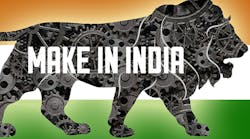India is doubling down on its money-losing steel industry.
Despite a global surplus and a record $47 billion of debt, companies including Tata Steel Ltd. and Jindal Steel & Power Ltd. plan to boost India’s capacity by 34%, with a third of the work set for completion by year-end, Bloomberg Intelligence estimates. The expansion might cost $33 billion at a time when many producers are hemorrhaging cash, according to India Ratings & Research.
The world’s third-largest steel industry is banking on a building boom as the economy rebounds in India, where the government is investing in new railways, power plants and housing. But a surge of cheaper Chinese imports has hurt domestic suppliers just like in Europe and the U.S., widening losses for companies already saddled with too much debt. Many producers are selling assets, while Electrosteel Steels Ltd. was among a few taken over by lenders.
“They don’t have the financial strength to invest further,” which means any large-scale increases in capacity are “not on the horizon for at least two to three years,” said Salil Garg, a director at India Ratings in New Delhi.
Prime Minister Narendra Modi wants to almost triple the size of the domestic industry over the next decade. He is seeking to reduce the country’s reliance on imports, part of a “Make in India” campaign that predates the global slump. The Steel Ministry estimates capacity will rise to 300 million metric tons by 2025 from 110 million now. So far, 37 million tons is under construction or planned, with 14.5 million set to be online by the end of 2016, said Yi Zhu, a Bloomberg Intelligence senior industry analyst.
Steel Authority of India Ltd., the country’s biggest producer, plans to increase capacity to 21.4 million tons from 13.9 million tons, while JSW Steel Ltd. said it will more than double to 40 million tons by 2025 from 18 million now. Tata Steel expects to begin producing this year from its Kalinganagar plant, with a capacity of 3 million tons.
But the new wave of expansions comes after years of investment in capacity increases that fueled a global surplus. Domestic iron and steel producers owe banks a record 3.1 trillion rupees ($45.93 billion), the Reserve Bank of India estimates. To reach Modi’s capacity goal, those companies would have to invest another 12 trillion rupees ($177.78 billion), based on an estimated 60 billion rupees ($888.89 million) for every 1 million-ton increase in capacity, according to India Ratings & Research.
Demand for domestic supplies has slowed as purchases of cheaper supplies from China, the world’s top producer, surged 20% to a record of 11.2 million tons in the year through March, government data show.
“In any scenario where demand is muted and additional capacities, once they come on stream, are unable to operate at optimum capacities, it becomes difficult to service debt,” said Garg of India Ratings.
Some companies are moving to shore up their balance sheets. Jindal Steel said on May 5 it will raise 30 billion rupees ($444.44 million) selling non-core assets, part of a plan to shrink debt below 300 billion rupees ($4.44 billion) in the next four years from 460 billion rupees now ($6.81 billion).
Like other countries, India has imposed levies to limit cheap Chinese imports and put a floor on slumping prices. Exports that reached a record by the end of March had slowed in April. That’s giving some producers more confidence to pursue expanded capacity.
The prolonged slump in prices is forcing some of the world’s producers to shut plants, easing the surplus. Last year, Chinese steelmakers exported a record 112 million tons. This year, shipments may drop to 100 million tons, the China Iron & Steel Association estimates.
More infrastructure spending also may help. The government is forecasting a 10% increase in steel demand this year, and India’s economy is growing faster than almost every other country. Gross domestic product will expand 7.7% in the year through March 2017, the most since 2010, according to the median estimate of 32 economists surveyed by Bloomberg.
Still, growth would need to be almost 12% a year to justify the government’s steel-expansion goal, which was made in 2012, before the current global slump, according to A.S. Firoz, chief economist with the Economic Research Unit of the Steel Ministry.
“At this moment, such growth rates are definitely not in sight,” Firoz said by telephone from New Delhi. The steel-capacity target “may have to be revised,” he said.
India needs better regulations, power availability and infrastructure improvement before its steel industry can take the torch from China, according to Bloomberg Intelligence’s Yi Zhu. India’s finished steel production fell 1.1% to 91 million tons in the year ended March 31, far outpacing consumption of 80.3 million tons, which was up 4%, according to the steel ministry.
“We have to tread very cautiously,” Jindal Steel Managing Director Ravi Uppal said in a May 5 interview. “The steel industry has gone through difficult times in the last one and a half years. The idea would be to focus on assets that are already built up rather than for a company to invest more and more.”
By Swansy Afonso



